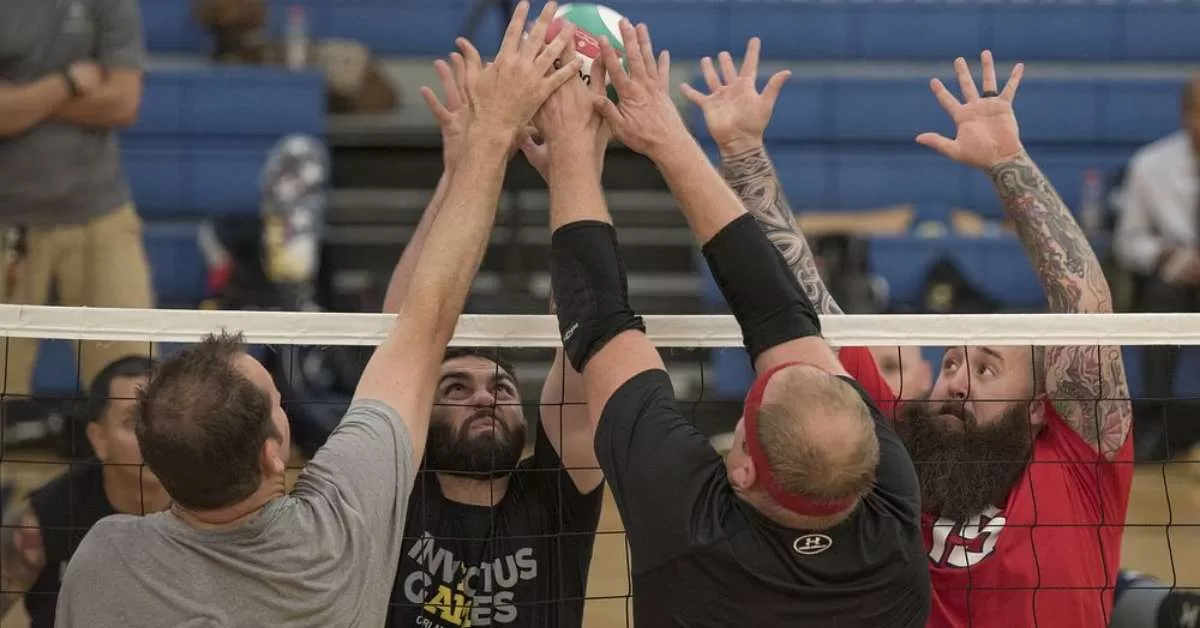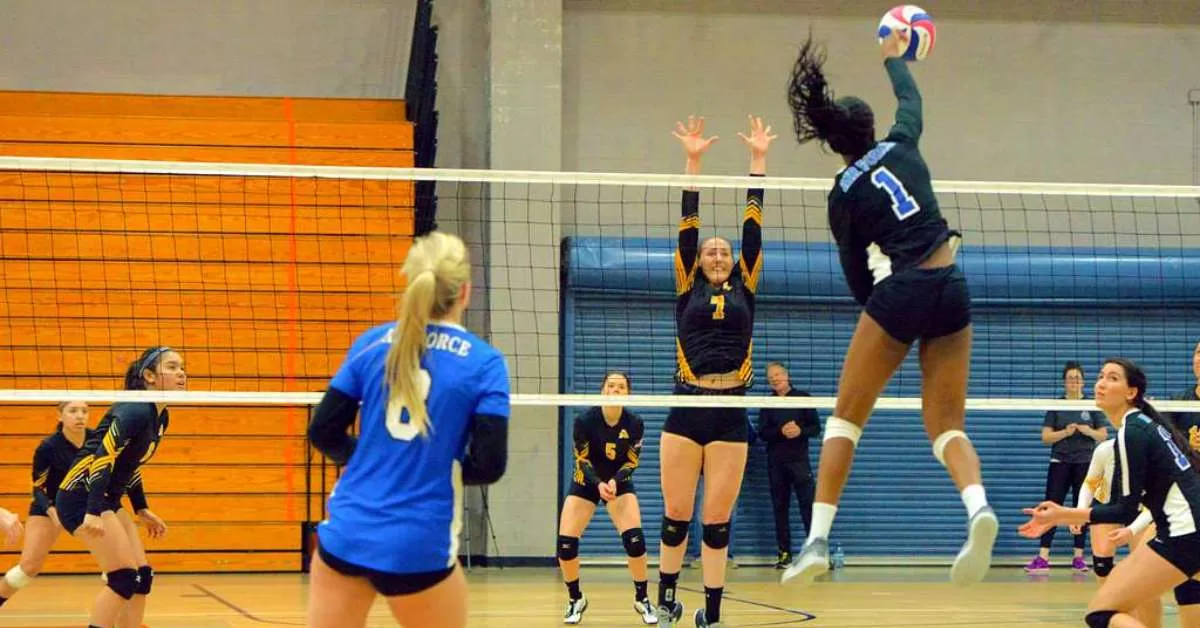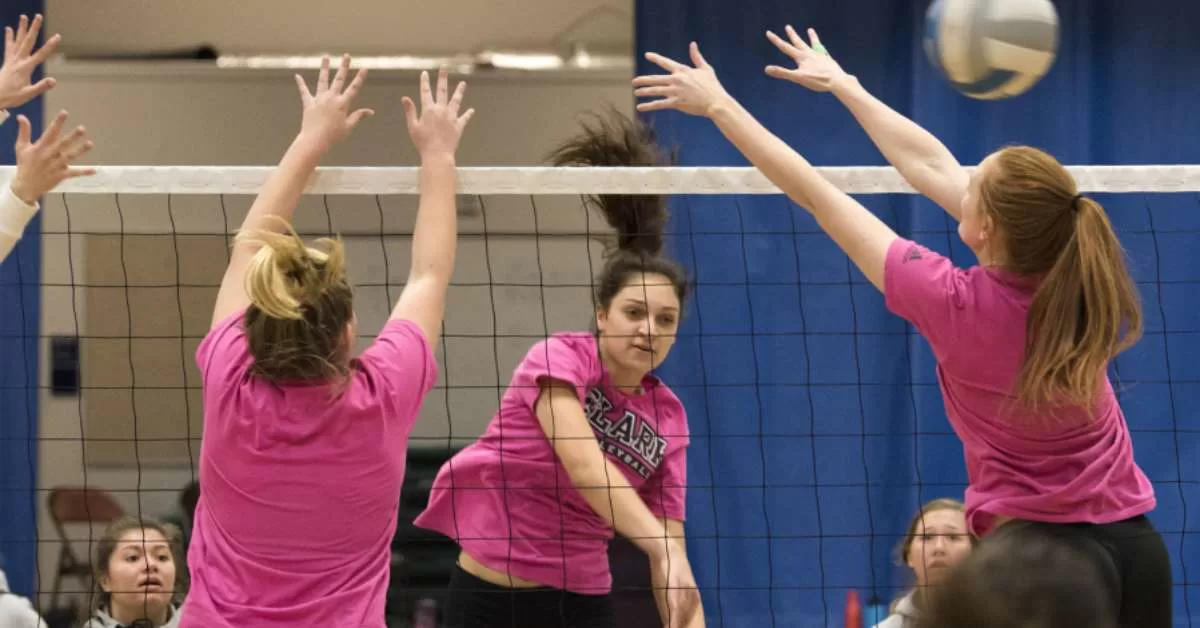Sometimes, keeping things simple is the best approach when it comes to volleyball practice. By focusing on basic drills, players can really work on improving their skills.
Today, we’ve got a list of essential drills that can help you become a top-notch middle-blocker in volleyball. These drills are like practice scenarios from real games and can be adjusted for different team sizes.
Volleyball Middle Blocker Drills: Volleyball middle blocker drills focus on improving blocking, hitting, and transitioning skills. These essential exercises enhance reaction time, timing, and overall performance for middle blockers on the court.
What makes them special is that they help you react quickly and get your timing right, which is super important for middle blockers. So, by practicing these drills, you’ll get better at blocking and be a valuable player for your team.
Volleyball Middle Blocker Drills: Step-By-Step

Volleyball middle blocker drills, step-by-step, guide players through exercises to enhance their blocking, hitting, and transitioning abilities, emphasizing key skills like reaction time and timing for improved performance on the court.
1. Footwork Drills for an Open Net
This simple middle-blocker drill is super effective. You stand near the net, like your home base. Imagine someone on the other side setting the ball to the side.
Move quickly, taking a big step, then a crossover step, and jump to block where a wing attacker would hit. If you really concentrate, this drill can make you a great blocker. But remember, it only works if you stay really focused.
Prevent Excessive Side-to-Side Movement:
When you jump to block, focus on going up, not sideways. It’s okay to move a bit sideways, but we don’t want to crash into our teammates. Most of the sideways movement should happen while your feet are still on the ground.
Prioritize Quick Initial Reactions:
When you begin, move really fast. In a real game, you can’t move until you know where the ball is going, so you need to catch up quickly. Even in practice with an empty net, imagine it’s a real game to make the drill effective.
Practice a Lot for Common Situations:
In this drill, we practice receiving the ball from the opponent’s setter and quickly blocking as a middle blocker. Even if the opposing middle isn’t a concern, we don’t know where the ball is going.
So, we have to react as fast as possible after seeing the set. This drill is crucial because it mirrors what happens when our team serves.
It’s the most common blocking situation, so we should practice it a lot, especially with a partner who can say ‘go’ to help with your reactions.
Your partner can do the same on the other side of the net. Remember, focus on reacting quickly and reducing sideways movement in the air.
2. Execute the Middle Play
“Execute the Middle Play” is a volleyball drill that involves middle hitters, passers, and blockers. It starts with the server and the middle blocker on one side of the court, while the middle hitter and three passers are on the opposite side.
The server serves the ball, and it goes to the other side. The middle hitter prepares for an attack. A passer receives the ball and passes it to the setter, who sets it for the middle hitter.
The hitter attacks and the blocker tries to block the ball. The goal is to have successful attack hits.
This drill is great for middle hitters, passers, and blockers. Passers need to focus on accurate passing to help the setter. Blockers can work on their blocking skills. Good passing makes setting easier, and blockers aim to block effectively.
3. Simple Quick Attack Drill

Here’s another very straightforward drill. It’s like the regular hitting lines drill but with just quick attacks. The middle blocker (MB) starts in position 1, sets the ball to the setter in position 2, and then quickly moves in to hit the ball.
The setter in position 2 sets the ball for the MB to attack. It’s a simple drill, but how much you benefit from it depends on how focused you are.
Practice Makes Perfect:
Find a setter who wants to improve too and practice quick attacks together. To become a better middle hitter, practice hitting more than your opponents.
Aim for 70% B-quicks and mix in some As and Cs. If you do this drill for an hour before or after training regularly, your hitting will get much better!
Explore Different Offensive Strategies:
Talk to your setter about which attack to use. Try As, Cs, and B-quicks. Aim for the back corners of the court, not the sharp angles. This will help you hit more effectively and efficiently.
4. Middle Intelligence Volleyball Drill
The “Middle Intelligence Volleyball Drill” involves players on both sides of the volleyball court. In the first version, a tosser throws the ball to their side’s setter, who sets it for a hitter to attack. The opposing team tries to block.
In the second version, the tosser sends the ball to a passer on the other side, who passes it to their setter, and then the hitter attacks. The key is for the middle hitter to watch the setter closely to anticipate the ball’s direction, helping their team score more points.
5. Delayed Blocking in Hitting Lines
We all know the basic ‘hitting lines’ drill. This is a simple twist with a middle blocker on the other side of the net. Here’s how it works: the hitter in position 1 tosses to the setter in position 2, who hits the ball back to 1.
After digging, 1 passes to the setter, who sets it outside. The hitter moves out to spike. The middle blocker starts near the setter and waits for the set to the outside before moving.
Then, the middle blocker quickly goes through the blocking sequence to block the outside hitter. It’s like a real game scenario based on the first drill.
Prioritize Quick Reactions to Setter’s Play:
Don’t try to guess the setter’s move. Wait until it’s clear where they’re setting the ball, just like in a real game. The longer you wait, the better.
Once you see the set going outside, act quickly and do the swing block. It’s like the first drill, but now you have a real target and a time limit.
Imagine it’s a serve-receive scenario where you’re reading the setter and reacting fast with good footwork to get there on time. And don’t drift too much in the air!
6. Coordinated Unpredictable Quick Attack Drill

This middle-blocker offense drill is super effective and easy. It’s like the previous one but with a dedicated tosser instead of the middle blocker tossing.
The tosser throws the ball to the setter randomly, at different heights and distances from the net, just like in real-game situations. Sometimes, the toss is flat, sometimes high, and sometimes too tight or too far from the net.
This helps the middle blocker practice timing and hitting quick attacks. The middle blocker should also start from different positions like they would during a game.
You can do this drill with just three people and adjust the difficulty by changing the toss. It’s a great way to train offense with two middles and a setter.
Serving and Passing Drills
“Serving and Passing Drills” involves various exercises in volleyball designed to enhance serving accuracy and passing skills. These drills are fundamental for developing a strong foundation in the sport. They include:
Serving Consistency and Accuracy
In this segment of the training regimen, the primary objective is to enhance serving skills with a focus on consistency and accuracy. The players engage in two specific types of serves: Jump Serves and Float Serves.
Jump serves concentrate on perfecting the jump serve technique, emphasizing both power and precision. On the other hand, Float Serves emphasize the development of the float serve, emphasizing control over the ball’s unpredictable movement.
Passing Drills for Middle Blockers
In this section, middle blockers delve into serve-receive techniques, a crucial aspect of their role in the game. These drills target the refinement of serve reception skills, which are essential for a smooth transition into offensive and defensive plays.
Players learn the intricacies of passing technique, including proper footwork, platform usage, and angle adjustments. Moreover, these drills emphasize effective communication among middle blockers and other passers to ensure accurate passes.
Additionally, middle blockers work on transitioning swiftly into attacking positions. These drills enhance their footwork and timing, allowing them to move efficiently from the net to their designated hitting spots.
This ensures that middle blockers are ready to make effective hits immediately after a successful pass, making valuable contributions to their team’s offensive plays.
These serving and passing drills are integral components of volleyball training, providing middle blockers with the skills needed to excel on the court, including serving consistency, passing proficiency, and the seamless transition from defense to offense.
FAQs About Volleyball Middle Blocker Drills
Q1. What are Volleyball Middle Blocker Drills?
Volleyball Middle Blocker Drills are specialized training exercises designed to enhance the skills and abilities of middle blockers in volleyball.
These drills focus on crucial aspects like blocking, hitting, transition, and serve reception, tailored specifically to the middle blocker’s role on the court.
Q2. Why are Middle Blocker Drills important?
Middle blockers play a vital role in both defense and offense during volleyball matches. These drills help them improve their blocking techniques, hitting efficiency, and ability to transition quickly from defense to attack. This is essential for the success of the team.
Q3. What skills do Middle Blocker Drills target?
Middle Blocker Drills target a range of skills, including blocking, hitting, serve reception, footwork, timing, and communication. These drills aim to develop a well-rounded skill set that is essential for an effective middle blocker.
Q4. Can these drills benefit players in other positions as well?
While Middle Blocker Drills are specifically designed for middle blockers, many of the skills and techniques practiced in these drills can be beneficial for players in other positions too.
Skills like serving, passing, and transitioning are fundamental to the game and can benefit all players.
Q5. How often should middle blockers practice these drills?
The frequency of practice varies depending on individual goals and team needs. However, regular practice is key to improvement.
Ideally, middle blockers should incorporate these drills into their training regimen several times a week to see significant progress and maintain their skills.
Conclusion:
To sum it up, the Volleyball Middle Blocker Drills we’ve discussed are like practice routines designed to help middle blockers in volleyball get better at their job.
These drills simplify different aspects of the game, like blocking and hitting, so players can improve step by step. They also help players react faster and get their timing right, which is super important for middle blockers.
By practicing these drills regularly, players can become more skilled at blocking and become valuable team members.
Additionally, there are Serving and Passing Drills that help players improve their serving accuracy and passing abilities, which are important for the whole team. These drills offer a solid foundation for players to develop their skills and become key players on the court.
After reading this detailed article, we hope you have a good understanding of Volleyball Middle Blocker Drills. If you have any questions, please don’t hesitate to ask in the comments!
